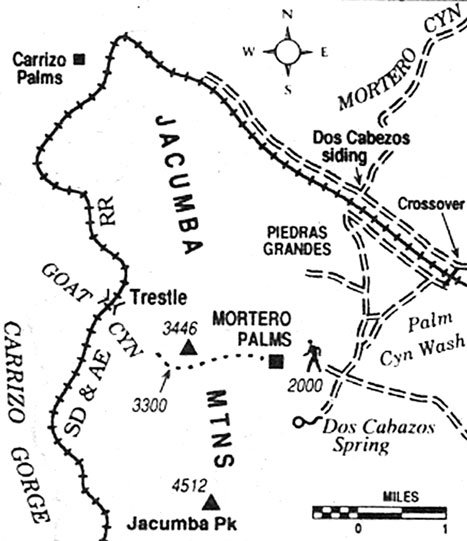 Facebook
Facebook
 X
X
 Instagram
Instagram
 TikTok
TikTok
 Youtube
Youtube

From the trailmaster’s favorites folder.
"Limmipedes,” my three-year-old son called them, those many-legged survivors from the Mesozoic era, marching across the sand in seemingly random directions, oblivious to our flashlight beams. Our land of limmipedes, otherwise known as Mortero Palms, was decorated with heaps of huge boulders and a huddle of palm trees. It was our home for a night, which we shared with a couple of coyotes, various insects, and assorted arthropods, but no other humans.
Mortero Palms lies in the southernmost reaches of the Anza-Borrego Desert State Park, not far from the old Dos Cabezos railroad siding. Thanks to Anza-Borrego’s open-camping policy, you can car camp or carry your overnight gear as near or far from the road end as you like and commune with nature without having to deal with reservations or fees. (Just remember that no open campfires are allowed, and you must not camp close to any water source.)
To get to Mortero Palms, drive east on I-8. Take the Highway S-2 exit at Ocotillo, and continue 4 miles to an unsigned dirt road on the left. Go south on this road and swing right after 1.1 miles. Continue west for another 4.6 miles, and turn left across the disused San Diego & Arizona Eastern railroad tracks on a paved crossover. Continue another 0.1 mile, then veer left, away from the tracks. Go another 1.6 miles, staying left at the next two junctions and then go right toward the Mortero Palms road end. (To check on the condition of these dirt roads, which might require high clearance or 4WD, call the park at 767-5311.)
The palms themselves lie in the canyon west, not south, of the road end. Look for bedrock mortars (grinding holes) below the first few palms. If you’re an accomplished, well-prepared desert hiker, you can push on past the grove and navigate through gauntlets of cholla cactus to reach a 3300-foot saddle in the Jacumba Mountains above. From there, you can head west into Goat Canyon, where you’ll have at least a distant view of the famous 200-foot-high wooden railroad trestle. Alternately, you can continue south along the mountain crest to reach 4512-foot Jacumba Peak, which offers an inclusive view of the Imperial Valley and the northern Baja desert.
Distance from downtown San Diego: 80 miles
Hiking length: 1 mile • Difficulty: Moderate


From the trailmaster’s favorites folder.
"Limmipedes,” my three-year-old son called them, those many-legged survivors from the Mesozoic era, marching across the sand in seemingly random directions, oblivious to our flashlight beams. Our land of limmipedes, otherwise known as Mortero Palms, was decorated with heaps of huge boulders and a huddle of palm trees. It was our home for a night, which we shared with a couple of coyotes, various insects, and assorted arthropods, but no other humans.
Mortero Palms lies in the southernmost reaches of the Anza-Borrego Desert State Park, not far from the old Dos Cabezos railroad siding. Thanks to Anza-Borrego’s open-camping policy, you can car camp or carry your overnight gear as near or far from the road end as you like and commune with nature without having to deal with reservations or fees. (Just remember that no open campfires are allowed, and you must not camp close to any water source.)
To get to Mortero Palms, drive east on I-8. Take the Highway S-2 exit at Ocotillo, and continue 4 miles to an unsigned dirt road on the left. Go south on this road and swing right after 1.1 miles. Continue west for another 4.6 miles, and turn left across the disused San Diego & Arizona Eastern railroad tracks on a paved crossover. Continue another 0.1 mile, then veer left, away from the tracks. Go another 1.6 miles, staying left at the next two junctions and then go right toward the Mortero Palms road end. (To check on the condition of these dirt roads, which might require high clearance or 4WD, call the park at 767-5311.)
The palms themselves lie in the canyon west, not south, of the road end. Look for bedrock mortars (grinding holes) below the first few palms. If you’re an accomplished, well-prepared desert hiker, you can push on past the grove and navigate through gauntlets of cholla cactus to reach a 3300-foot saddle in the Jacumba Mountains above. From there, you can head west into Goat Canyon, where you’ll have at least a distant view of the famous 200-foot-high wooden railroad trestle. Alternately, you can continue south along the mountain crest to reach 4512-foot Jacumba Peak, which offers an inclusive view of the Imperial Valley and the northern Baja desert.
Distance from downtown San Diego: 80 miles
Hiking length: 1 mile • Difficulty: Moderate